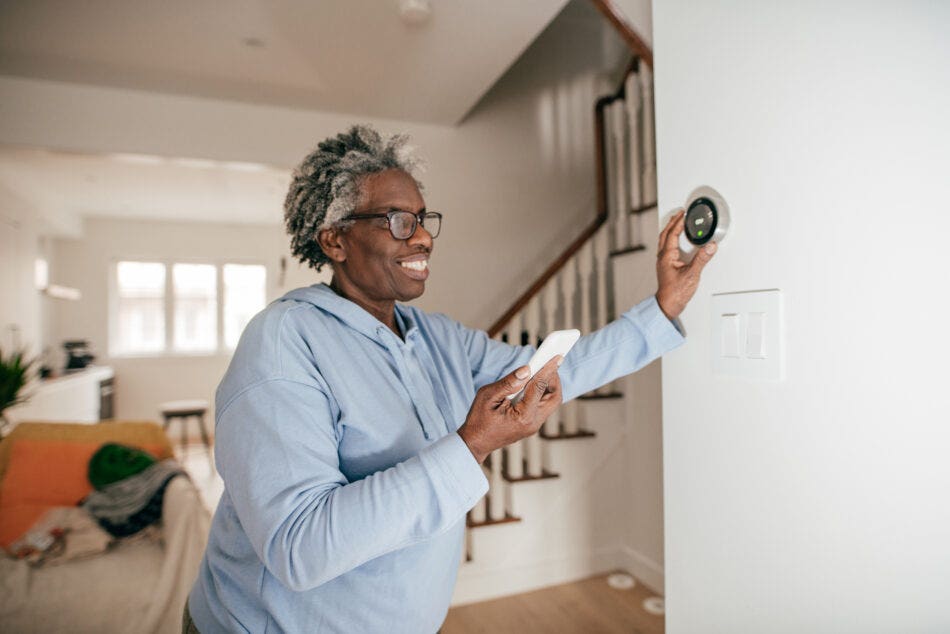Smart devices such as speakers, thermostats, security systems and appliances, offer a level of convenience and peace of mind that many Canadians enjoy. In 2022, 47% of Canadians surveyed for the Canadian Internet Use Survey reported that they used internet-connected smart home devices, with the number of users steadily climbing year-over-year.
However, these devices can leave your home vulnerable to cyberattacks if the proper security measures aren’t taken.
In this blog we will discuss the risks associated with smart devices and how you can protect your home and loved ones while also considering the benefits of adding cyber coverage to your home insurance policy.
What is a smart home device?
Smart home technology will typically connect your security systems, Wi-Fi enabled appliances, lighting, heating and air conditioning to a central hub that is controlled through your smartphone, tablet or laptop.
There are some great benefits to smart home automation — these devices are convenient, energy efficient and provide home security. You can create schedules and presets that align with your daily routine and activities to ensure you’re optimizing your homes energy usage based on the time of day.
Being able to turn your furnace up so your house is nice and warm when you get home from work on a cold day, or double check when a package was delivered to your front door are just a couple of examples why Canadians enjoy smart home technology.
What’s interesting about smart home devices is that, although their use continues to rise among Canadians each year, 28% of respondents in the Canadian Internet Use Survey expressed that they do not trust them.
Identifying the cyber risks of smart devices
While there can be some definite benefits to smart home automation, there are also drawbacks. Smart devices, if not properly secured, can serve as an entry point for hackers looking to steal your personal information or spy on your household.
This can be done through several different types of attacks that include:
- Phishing attacks that appear to look like they come from one of your smart home security companies. Entering your login information or clicking on the fake links to malware that is designed to take over your device, may give cybercriminals access to your home and Wi-Fi network.
- Automated online bot attacks that will scan and test internet-connected devices to see if accounts can be broken into. This is usually done with password guesses that blast devices with login attempts. If it successfully guesses your password, the bot will infect your device and connect it to a botnet for future data theft and cyberattacks.
- Company based data breaches where cybercriminals successfully gain access to a company’s user database and access account login details, personal info about location and addresses, as well as photo or video footage that is stored in their cloud.
Wyze, which specializes in smart home security products and wireless cameras, reported in early 2024 that over 13,000 accounts had been compromised in a hack that shared photos and video footage from inside other users homes.
How to protect your smart home from cyberattacks
While a targeted attack to your specific smart home devices is not very likely to happen, it’s still important to practice good cyber hygiene to keep yourself and your loved ones safe. Some easy security practices include:
- Secure your network by using strong passwords that you change regularly. Long complicated passwords with a minimum of 16 characters work best to guard against bot attacks, especially with your Wi-Fi router. If you struggle with remembering all of your passwords, enlist a password manager program to help you.
- Enable multi-factor authentication for all your smart devices. This ensures that even if cybercriminals get your password, they won’t be able to login without another form of authentication.
- Make sure to regularly check that all the firmware on your devices is updated. Firmware is software that is installed by the manufacturer and typically irremovable that provides basic instructions to a device’s hardware, enabling it to function. Running older firmware versions can leave your devices vulnerable to hackers who can exploit unpatched flaws in the software.
- Before purchasing a smart home device, do your research and buy from a trusted brand that uses strong encryption to help protect your data. Don’t forget to review security and privacy policies so that you know where and how your information is being stored.
- Create separate Wi-Fi networks so that your smart home devices are kept isolated from the main network that your computer, phone and tablet are connected to. This way any malware that may infect your smart home devices is less likely to be able to infect and access the more valuable information on your laptop or phone.
- Invest in cyber insurance. Cyber insurance helps protect you financially if you’re the victim of cybercrimes such as online fraud, cyberattacks and data breaches. If you have a claim, the insurer works with you to help mitigate the damage so you can recover and protect yourself financially.
Acera Insurance is your partner in cyber security
If you have questions about cyber coverage, whether its best for you to have a standalone policy or add cyber coverage to your home insurance policy, our cyber specialists can help guide you through the process. They can address any questions you have about cyber insurance and collaborate with you to create a policy tailored to your specific needs.
Start a conversation with one of our expert advisors today to determine the right coverage for you.

